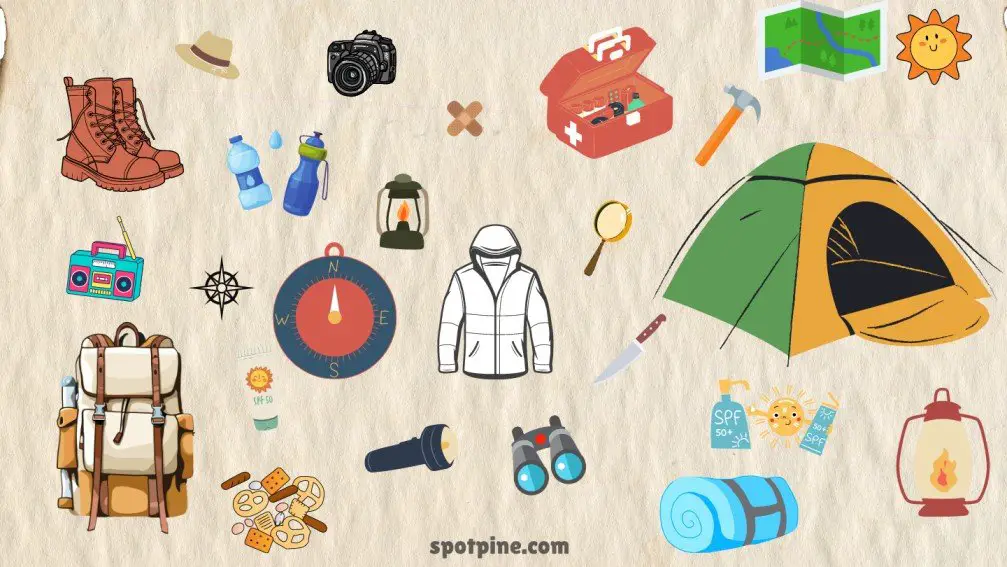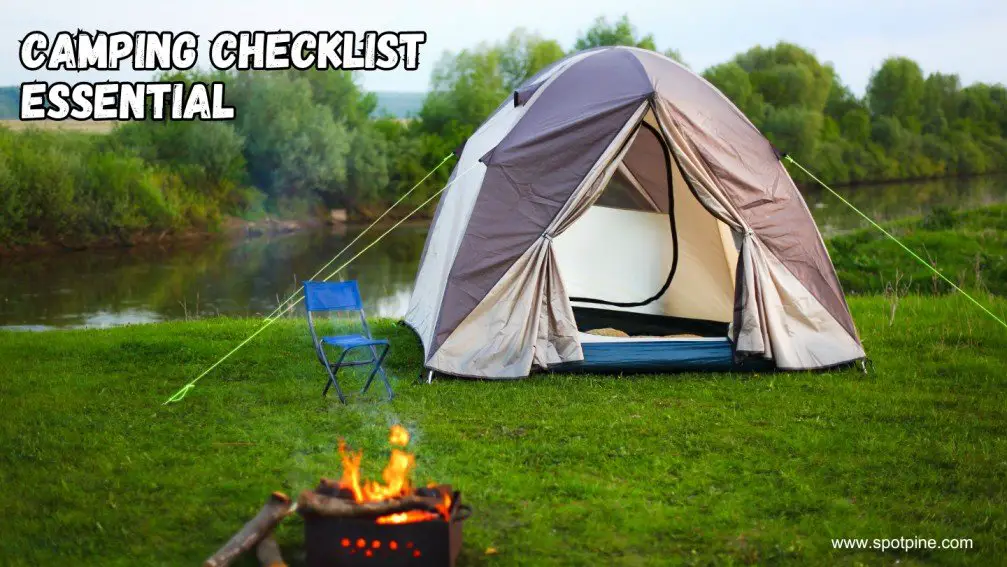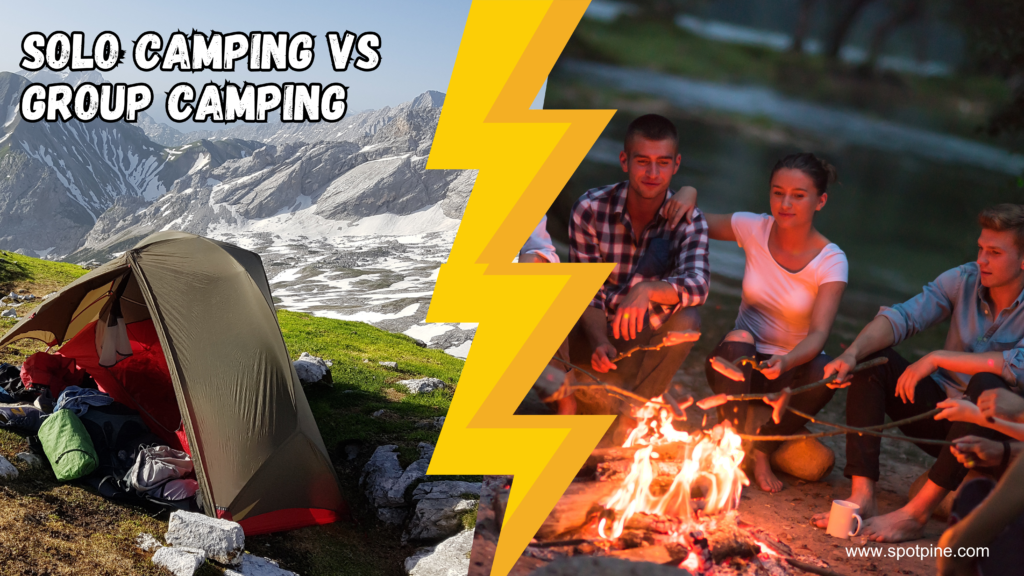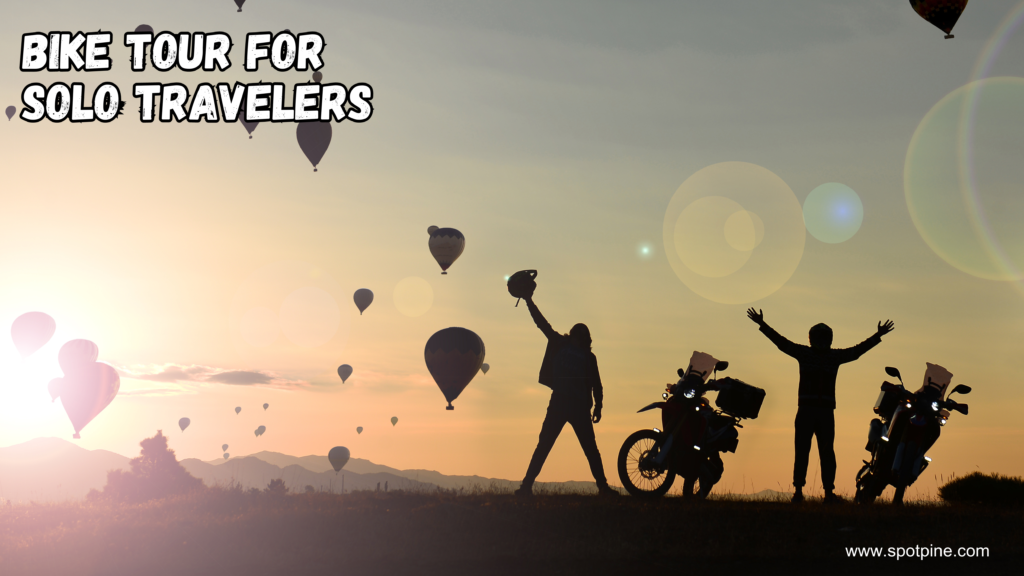A camping checklist ensures you pack all the essentials for a successful trip. It includes gear, clothing, food, and safety items.
Camping offers a thrilling escape into nature, but forgetting key items can spoil the experience. Preparing a detailed checklist helps ensure you have everything needed for a comfortable, safe, and enjoyable adventure. Essential gear includes a tent, sleeping bag, and cooking supplies.
Pack appropriate clothing for varying weather conditions, and don’t forget food and water supplies. Safety items like a first aid kit, map, and flashlight are crucial. With a well-prepared checklist, you can focus on enjoying the great outdoors without any hiccups. Happy camping!

Introduction To Camping Essentials
Embarking on a camping adventure is exciting. The right gear can make or break your trip. This guide helps you pack smartly for a successful camping experience.
Why Packing Right Matters
Packing the right gear is crucial for a safe and enjoyable camping trip. Proper equipment ensures you are prepared for any situation. Forgetting important items can lead to discomfort and potential danger.
Consider the weather, terrain, and duration of your trip. These factors influence your packing list. A well-prepared camper is a happy camper.
The Balance Between Comfort And Practicality
Finding the balance between comfort and practicality is key. Overpacking can make your trip burdensome. Underpacking can leave you unprepared. Aim for a mix of essential and comfort items.
Essentials should include:
- Tent – Shelter from the elements
- Sleeping bag – Keeps you warm at night
- First aid kit – For minor injuries
- Food and water – Sustain energy and hydration
Comfort items can include:
- Portable chair – For relaxing by the campfire
- Pillow – A good night’s sleep is essential
- Extra blanket – Added warmth on chilly nights
Always prioritize safety and comfort. A balanced packing list enhances your camping experience.
Shelter And Comfort
When camping, ensuring proper shelter and comfort is essential. A good shelter protects you from the elements. Comfortable sleeping arrangements ensure a restful night. This section covers choosing the right tent and sleeping gear.
Choosing The Right Tent
Selecting the right tent is crucial for your camping experience. A good tent provides protection from rain, wind, and insects. Consider the size of your group. Choose a tent that offers enough space. Look for features like weather resistance and ease of setup. Here’s a simple table to help you decide:
| Group Size | Tent Type |
| Solo | 1-person tent |
| Couple | 2-person tent |
| Family | 4+ person tent |
Find Out The 10 Best Waterproof Tents of 2024
Sleeping Bags And Pads For A Good Night’s Sleep
A good night’s sleep is important for enjoying your camping trip. Choose the right sleeping bag and pad for comfort. Sleeping bags come in different temperature ratings. Select one suitable for the weather you expect. Here are some tips:
- Check the temperature rating of the sleeping bag.
- Choose a sleeping pad for added comfort.
- Consider weight and packability if hiking.
Sleeping pads provide cushioning and insulation from the ground. There are three main types:
- Foam pads – Lightweight and affordable.
- Self-inflating pads – Offer good comfort and insulation.
- Air pads – Compact but need inflation.
With the right tent and sleeping gear, your camping experience will be more enjoyable. Proper shelter and comfort ensure you wake up refreshed and ready for adventure.
Find Out 5 Best Backpacking Sleeping Bags and Pillows of 2024
Nutrition In The Wild
Camping is a great way to connect with nature. Proper nutrition is essential for a successful trip. Eating well keeps your energy high and your spirits up.
Portable Stoves And Fuel
A portable stove is essential for cooking in the wild. Choose a lightweight stove. Make sure it is easy to use. Bring enough fuel for your trip. There are many fuel options available:
- Propane
- Butane
- Liquid fuel
Check your stove’s compatibility with the fuel. Always carry extra fuel. Safety is important. Store fuel away from the fire. Follow the manufacturer’s instructions for use.
Nutritious And Easy-to-carry Food Options
Food should be lightweight and nutritious. Choose foods that are easy to pack. Here are some great options:
- Dried fruits and nuts
- Trail mix
- Granola bars
- Instant oatmeal
For meals, consider the following:
- Dehydrated meals
- Canned beans and soups
- Instant noodles
Don’t forget snacks. They provide quick energy. Great snack options include:
- Beef jerky
- Energy bars
- Crackers and cheese
Water is vital. Carry a water filter or purification tablets. Stay hydrated throughout your trip.
| Item | Reason |
| Portable stove | For cooking meals |
| Fuel | To power the stove |
| Dried fruits | Lightweight and nutritious |
| Trail mix | Quick energy boost |
Eating well in the wild is easy with the right preparation. Choose foods that are easy to pack and cook. Stay safe and enjoy your adventure!
Clothing For All Conditions
Planning a camping trip? You need the right clothes. Proper clothing keeps you warm, dry, and safe. Let’s explore the best strategies to pack for any weather.
Layering Strategies
Layering is key to staying comfortable. Use three main layers:
- Base Layer: This layer touches your skin. Choose moisture-wicking fabrics like polyester or merino wool. They keep you dry by moving sweat away.
- Insulating Layer: This layer traps body heat. Opt for fleece or down jackets. They are light but warm.
- Outer Layer: This layer protects you from wind and rain. A waterproof and breathable jacket works best. Look for materials like Gore-Tex.
Protective Gear For Rain And Sun
Weather can be unpredictable. Be ready for both rain and sun.
| Rain Protection | Sun Protection |
Rain Jacket: A waterproof jacket keeps you dry. It should be breathable to avoid sweat buildup.Rain Pants: Waterproof pants are useful. They protect your legs from getting wet.Waterproof Boots: Keep your feet dry. Choose boots with good traction. | Sun Hat: A wide-brimmed hat protects your face and neck.Sunglasses: Protect your eyes from UV rays. Choose polarized lenses for clarity.Sunscreen: Apply sunscreen to exposed skin. SPF 30 or higher is best. |
With these tips, you can enjoy your camping trip in any weather. Stay prepared and stay comfortable!
Navigating Nature
Heading into the great outdoors can be thrilling. But getting lost is no fun. That’s why a good navigation plan is crucial for any camping trip. Whether you are a seasoned hiker or a beginner, understanding how to navigate nature can make your adventure safer and more enjoyable.
Maps, Compasses, And Gps Devices
Maps are the most traditional way to navigate. They provide a visual layout of the terrain. Make sure your map is up-to-date and detailed. Topographic maps are best for hiking and camping.
- Topographic maps show elevation changes.
- Always keep your map in a waterproof case.
Compasses are essential tools for navigation. They help you find directions when landmarks are not visible. Learn how to use a compass before your trip.
- Hold the compass flat in your hand.
- Align the needle with the north on your map.
GPS Devices provide real-time location data. They are very accurate and user-friendly. Always carry extra batteries or a portable charger for your GPS device.
- Make sure to download offline maps.
- Familiarize yourself with the GPS interface.
Understanding Trail Markings
Trail markings are signs that guide you along the path. They can be found on trees, rocks, or posts. Knowing what these markings mean can help you stay on track.
- Blazes: These are colored marks on trees or rocks. They indicate the trail path.
- Cairns: Piles of rocks used to mark trails in open areas. Follow the line of cairns to stay on the trail.
- Trail Signs: Wooden or metal signs with information about the trail. They often include distances and directions.
Keep an eye out for these markings. They are there to help you. Always double-check your route with your map and compass.
| Navigation Tool | Purpose | Tips |
| Map | Visual layout of terrain | Use a waterproof case |
| Compass | Find directions | Align needle with north |
| GPS Device | Real-time location data | Carry extra batteries |
| Trail Markings | Guide along path | Look for blazes and cairns |
Health And Safety Gear
Camping is a fun adventure. But staying safe is important. You need the right Health and Safety Gear. This makes sure you are ready for any surprise. Here is what you need to pack:
First Aid Kits
A First Aid Kit is a must. It can help with small injuries. Here’s what to include:
- Bandages
- Gauze pads
- Antiseptic wipes
- Adhesive tape
- Scissors
- Tweezers
- Pain relievers
- Antibiotic ointment
Check your kit before each trip. Replace any used items. Keep it in a waterproof bag.
Emergency Communication Tools
It’s important to stay in touch. Emergency Communication Tools can help. Here are some tools to consider:
- Cell phone with a full charge
- Portable charger
- Satellite phone
- Two-way radios
- Whistle
- Signal mirror
These tools can save lives. Always keep them within reach. Make sure they are in good working condition before your trip.
Stay safe and have fun camping! Prepare well and enjoy your adventure.
Sustainable Camping Practices
Camping allows us to reconnect with nature. Practicing sustainable camping ensures these beautiful spaces remain for future generations. This guide covers essential tips for eco-friendly camping.
Leave No Trace Principles
The Leave No Trace principles help protect natural environments. These principles include:
- Plan ahead and prepare
- Travel and camp on durable surfaces
- Dispose of waste properly
- Leave what you find
- Minimize campfire impact
- Respect wildlife
- Be considerate of others
Following these rules keeps the environment clean and safe. Always pack out all trash and belongings.
Eco-friendly Products And Packing
Using eco-friendly products reduces your environmental footprint. Here are some suggestions:
- Biodegradable soap and shampoo
- Reusable water bottles and utensils
- Solar-powered chargers
- Recycled or sustainable camping gear
Packing efficiently also helps. Use reusable containers instead of plastic bags. Opt for lightweight gear to reduce fuel consumption during travel.
Here’s a quick table for an eco-friendly packing list:
| Item | Eco-Friendly Option |
| Water Bottle | Stainless Steel or Glass |
| Utensils | Bamboo or Metal |
| Soap | Biodegradable |
| Charger | Solar-Powered |
By following these tips, you can enjoy nature responsibly. Let’s protect our planet for future adventurers.
Entertainment And Recreation
Camping is not just about setting up a tent and sleeping outdoors. It’s also about enjoying various activities that keep everyone entertained. Having a good mix of entertainment and recreation can make your camping trip memorable. Below, we’ll dive into some of the best ways to stay entertained and engaged during your camping adventure.
Outdoor Games
Outdoor games are a fantastic way to keep everyone active and engaged. Here are some fun and simple games to include:
- Frisbee: Perfect for all ages and requires minimal space.
- Badminton: Easy to set up and fun for small groups.
- Scavenger Hunt: Create a list of items to find in nature.
- Horseshoes: A classic game that’s easy to play and set up.
Pack lightweight and portable games to save space in your gear. These activities help everyone stay active and engaged throughout the day.
Photography And Nature Observation
Camping provides a unique opportunity to connect with nature. Photography and nature observation are great ways to capture and appreciate your surroundings. Here are some tips to enhance your experience:
- Bring a Camera: Capture stunning landscapes and wildlife.
- Binoculars: Perfect for bird watching and observing distant objects.
- Nature Journal: Document your observations and sketches.
- Field Guides: Identify plants, animals, and stars.
These tools help you deepen your connection with nature and create lasting memories. Spend time observing the small details around you, from the flutter of a butterfly to the rustle of leaves.
Final Checklist Before Departure
Before heading out for your camping adventure, it’s crucial to go through a final checklist. This ensures nothing important is left behind. A well-prepared checklist covers all essentials, last-minute items, and checks on weather and route conditions.
Last-minute Items
- Phone and Charger: Ensure your phone is fully charged. Pack a portable charger.
- Wallet: Double-check for ID, money, and any necessary cards.
- Keys: House, car, and any additional keys.
- Snacks and Water: Pack extra snacks and water bottles for the journey.
- First Aid Kit: Ensure it’s fully stocked with bandages, antiseptic, and pain relievers.
Checking Weather And Route Conditions
Before departure, it’s important to check the weather and route conditions. This helps in planning and staying safe.
Use reliable weather apps to check the forecast for your camping location.
| Weather Condition | Action Required |
| Rain | Pack waterproof gear and extra tarps. |
| Extreme Heat | Pack extra water and sunscreen. |
| Cold | Pack extra layers and thermal blankets. |
Check road conditions to avoid delays. Use GPS or traffic apps.
Ensure your vehicle is in good condition. Check tire pressure and fuel levels.
Conclusion: Embracing The Great Outdoors
Camping brings us close to nature. It offers peace and adventure. Packing the right gear ensures a great trip. A good checklist helps you remember everything. Let’s reflect on our journey and plan the next adventure.
Reflecting On The Journey
Camping trips create lasting memories. You remember the crackling campfire, the fresh morning air, and the starry nights. Reflecting on these experiences brings joy. It helps you appreciate the beauty of nature. Think about what you loved most. Did you enjoy hiking, fishing, or just relaxing?
Learning from each trip makes the next one better. Did you forget something important? Make a note. Did you bring something you didn’t need? Adjust your list. Reflecting helps you plan better for the future.
Planning Your Next Adventure
Planning your next camping trip can be exciting. Use your past experiences to guide you. Update your checklist with new ideas. Always pack the essentials:
- Tent and Sleeping Gear: Tent, sleeping bag, pillow
- Cooking Supplies: Stove, cookware, utensils
- Clothing: Weather-appropriate clothes, extra layers
- Safety Items: First-aid kit, flashlight, map
Consider the activities you want to do. If you love hiking, pack sturdy shoes. If you plan to fish, bring your gear. Tailor your checklist to your interests. This ensures you have everything you need.
Here’s a simple table to help you plan:
| Item | Essential? |
| Sleeping Bag | Yes |
| Portable Stove | Yes |
| Fishing Gear | Optional |
| Hiking Boots | Yes |
Remember to check weather forecasts. Pack accordingly. Stay safe and have fun. Each trip is a new adventure. Enjoy the great outdoors!
Credit: www.vertex42.com
FAQs:
What Do I Actually Need For Camping?
For camping, you’ll need a tent, sleeping bag, camping stove, food, water, clothing, first aid kit, and navigation tools.
What Might I Forget About Camping?
Don’t forget essentials like a first aid kit, extra batteries, insect repellent, and a map. Bring waterproof gear and extra socks.
What To Bring Camping For One Night?
Bring a tent, sleeping bag, flashlight, water, snacks, warm clothing, first-aid kit, and essential toiletries for one night camping.
How Do I Make A Camping Checklist?
Create a camping checklist by categorizing items: shelter, clothing, food, cooking gear, safety, and personal items. Prioritize essentials.
Packing the right gear ensures a great camping experience. Use our checklist to stay organized and prepared. Enjoy the beauty of nature without stress. Safe travels and happy camping!



